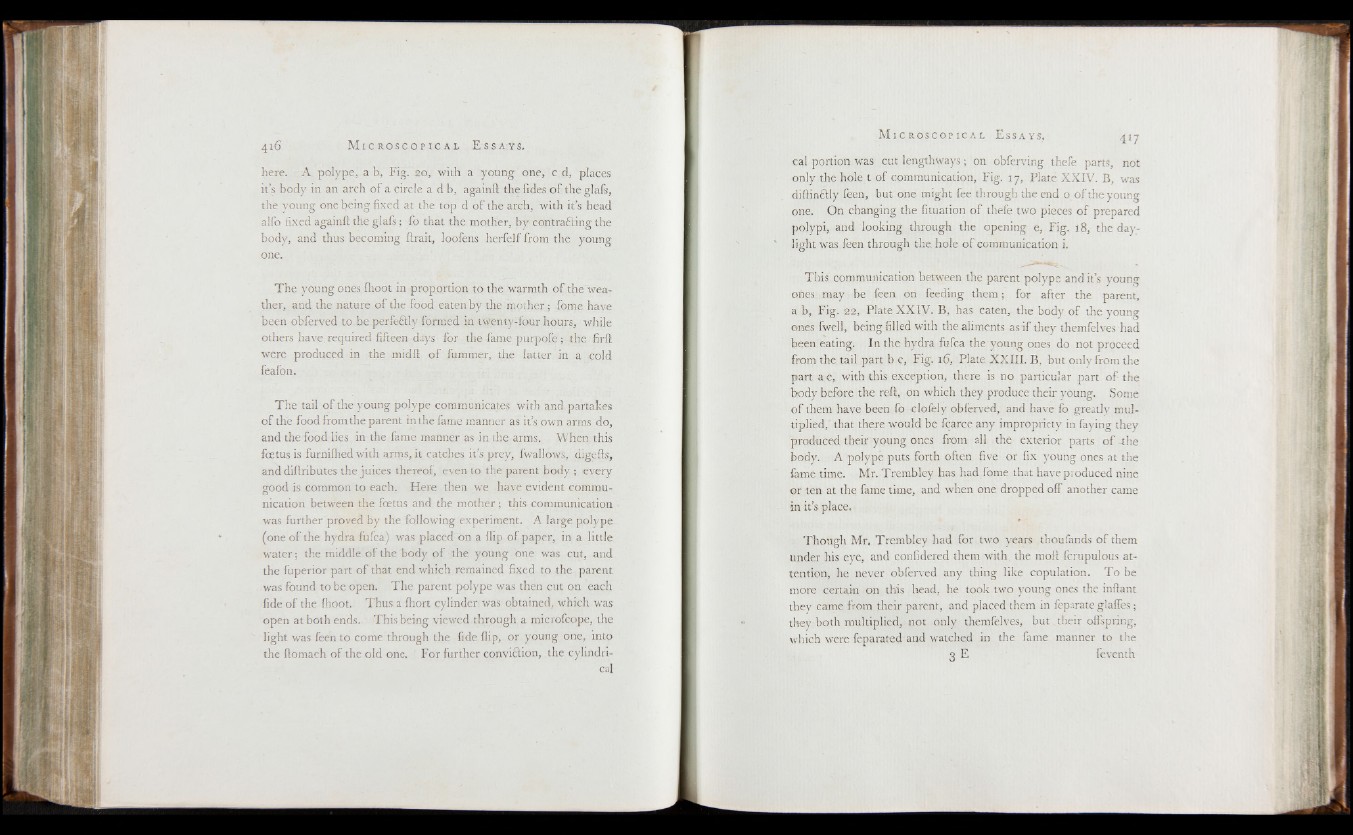
here. A polype, a b, Fig. 20, with a young one, c d, places
it’s body in an arch of a circle a d b, againft the hides o f the glafs,
the young one being fixed at the top d of the arch, with it’s head
alfo fixed againft the glafs ; fo that the mother, by contra filing the
body, and thus becoming lirait, loofens herfelf from the young
one.
The young ones fhoot in proportion to the warmth of the weather,
and the nature of the food eaten by the mother ; fome have
been obferved to be perfefilly formed in twenty-four hours, while
others have, required fifteen days for the fame purpofe ; the firft
were produced in the midft o f fummer, the latter in a cold
feafon.
The tail of the young polype communicates with and partakes
o f the food from the parent in the fame manner as it’s own arms do,
and the food lies in the fame manner as in the arms. When this
foetus is furnifhed with arms, it catches it’s prey, fwallows, digefts,
and diftributes the juices thereof, even to the parent body ; every
good is common to each. Here then we have evident communication
between the foetus and the mother ; this communication
was further proved by the following experiment. A large polype
(one o f the hydra fufca) was placed on a flip of paper, in a little
water ; the middle of the body o f the young one was cut, and
the fuperior part of that end which remained fixed to the parent
was found to be open. The parent polype was then cut on each
fide of the fhoot. Thus a fhort cylinder was obtained, which was
open at both ends. This being viewed through a microfcope, the
light was feen to come through the fide flip, or young one, into
the ftomach o f the old one. For further conviction, the cylindrical
cal portion was cut lengthways; on obferving thefe parts, not
only the hole t o f communication, Fig. 17, Plate XXIV. B, was
diftinfilly feen, but one might fee through the end o o f the young
one. On changing the Situation o f thefe two pieces o f prepared
polypi, and looking through the opening e, Fig. 18, the daylight
was feen through the. hole of communication i.
This communication between the parent polype and it’s young
ones: may be feen on feeding them; for after the parent,
a b, Fig. 22, Plate XXIV. B, has eaten, the body of the young
ones fwell, being filled with the aliments as i f they themfelves had
been eating. In the hydra fufca the young ones do not proceed
from the tail part b c, Fig. 16, Plate XXIII. B, but only from the
part ac, with this exception, there is no particular part o f the
body before the reft, on which they produce their young. Some
of them have been fo clofely obferved, and have fo greatly multiplied,'
that there would be fcarce any impropriety in faying they
produced their young ones from all the exterior parts o f -the
body. A polype puts forth often five or fix young ones at the
fame time. Mr. Trembley has had fome that have pioduced nine
or ten at the fame time, and when one dropped off another came
in it’s place.
Though Mr. Trembley had for two years thoufands of them
under his eye, and confidered them with the moft fcrupulous attention,
he never obferved any thing like copulation. To be
more certain on this head, he took two young ones the inftant
they came from their parent, and placed them in feparate glaffes;
they both multiplied, not only themfelves, but their offspring,
which were feparated and watched in the fame manner to the
3 E feventh